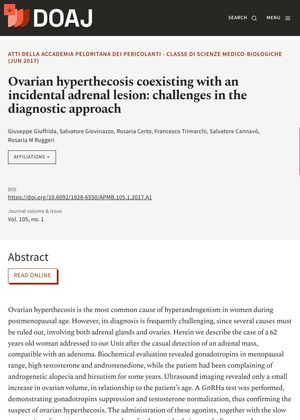Ovarian Hyperthecosis Coexisting with an Incidental Adrenal Lesion: Challenges in the Diagnostic Approach
May 2017
in “
DOAJ (DOAJ: Directory of Open Access Journals)
”

TLDR Using GnRHa agonists helps diagnose and treat ovarian hyperthecosis when surgery isn't possible.
The document from June 2017 discussed a case of a 62-year-old woman with ovarian hyperthecosis, a common cause of hyperandrogenism in postmenopausal women, who also had an incidental adrenal mass. The patient had high testosterone and androstenedione levels and had been experiencing androgenetic alopecia and hirsutism for several years. A GnRHa test confirmed the diagnosis of ovarian hyperthecosis by showing gonadotropin suppression and testosterone normalization. The study concluded that the use of GnRHa agonists was crucial in excluding an androgen-secreting neoplasia and limiting the use of ovarian veins catheterization. The agonists were also considered a valid therapeutic option when surgery was contraindicated or could not be performed.




